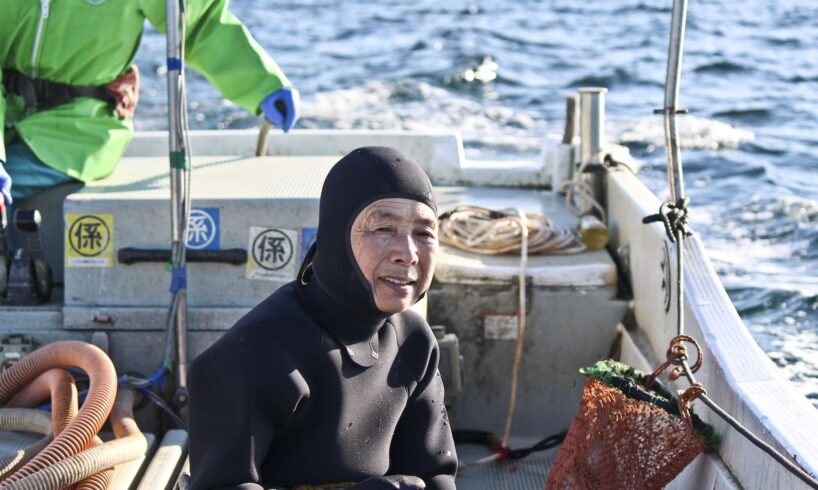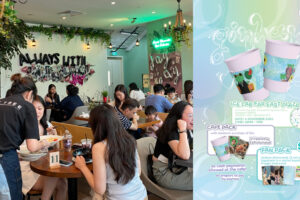
Chizuko Nakamura (Funado) Pre Dive Credit: Christopher Douglas
Nowhere is Japan’s deep connection to the sea more apparent than in the Ise-Shima region of Mie Prefecture. While most visitors are drawn inland to the Ise Grand Shrine, Shinto’s holiest place of worship, a trip to the coast is well worth it to meet the ama.
Written with the characters 海女 (ama) meaning “sea woman,” these fearless female divers still live and work as they have for thousands of years. They refuse to use modern equipment such as scuba gear or oxygen tanks, relying solely on holding their breath. Most famous for historically harvesting pearls, most of the ama’s actual catch today is the seafood the region is famed for, such as abalone.
Toba and Shima together are home to nearly half of Japan’s remaining 2,000 ama—a number that is rapidly dwindling. The average age of these divers is around 70 and climbing, with some ama continuing to dive well into their 80s.
A Life Beneath the Waves: Nakamura Chizuko of Osatsu
Chizuko Nakamura (Funado) Pre Dive Credit: Christopher Douglas
Nakamura Chizuko, 72, was born and raised in the Osatsu area of Toba, a region that claims to have the highest concentration of active ama in Japan.
“Since around fifth grade, I spent my summer vacations diving for abalone,” she reminisces. “My mother was also an ama, so as a child, I would add my catch to the seafood the sea women had gathered.”
Nakamura became a professional diver at 20 and now has over five decades of experience. “Being an ama is part of my life—a source of income and energy. For me, it has been something natural, ever since childhood.”
Chizuko Nakamura (Funado) Emerging wth namako Credit: Christopher Douglas
As her family also works in fishing, her day begins at 3 am, hauling up nets and sorting the fish by type. Then she heads out for diving. “My day usually ends around 3 pm,” she says. “If there’s no work at the ama hut, I might spend the whole day farming.”
The hut that Nakamura refers to is part of the Osatsu-kamado Ama Hut Experience, where guests savor succulent meals of freshly caught seafood grilled over charcoal—often prepared by the very ama who harvested it. This project helps divers supplement their income while preserving and sharing their culture with visitors.
Osatsu Kamado Grilled BBQ Credit: Toba CCI
Osatsu Kamado Grill Credit: Toba CCI
Learn more about Japanese-style barbecue: The Ultimate Japanese BBQ Guide: Grilling Tips, Recipes and Must-Try Foods
Climate Change and the Future of Ama Diving
Nakamura says that there are both joys and challenges to being an ama. “The most enjoyable part is talking with my fellow divers after we come up from the sea. However, the schedule is tight and there are so many things to do. I’m always racing against the clock.”
She’s also concerned about the future—not just the lack of new divers, but increasingly, the effects of climate change. “Due to global warming, sea temperatures are rising, and the marine life we harvest is decreasing in number.”
From California to Shima: The Story of Hayashi Kimiyo
Hayashi Kimiyo, 71, was born in Shima but, curiously, got started as an ama in America.
“After graduating from junior high school, I went to the U.S. and worked in San Diego and Los Angeles for two years doing ama diving shows for tourists,” she recalls.
After returning to Japan and continuing to dive in Nanki Shirahama for 12 years, she eventually returned to Shima at age 29 and became “a real ama.” More than 40 years later, she’s still going.
“Being an ama is my life, it’s a job I love—both my mother and grandmother were sea women.”
Her typical day starts with a trip to the beach at 8 am, where she builds a fire in the ama hut to warm up. At 10 am, she changes and heads out to sea to dive for an hour. After a lunch break, she heads back for a second dive at 1 pm, spending another hour harvesting.
Photo by IST Co., Ltd.
Photo by IST Co., Ltd.
The Changing Sea and a Vanishing Profession
Until recently, divers used to go out to sea about 100 days a year, but Hayashi says she has been out to sea far less lately. “The marine environment has deteriorated, and there are fewer abalone, the main catch for ama. The sea is in a state known as isoyake, where seaweed on which abalone feeds is rapidly declining.”
As a result, abalone populations have declined, along with the income of ama divers themselves—making the profession even less appealing to younger generations.
In order to fight isoyake, the city hall is leading efforts to eradicate gangaze, a sea urchin-like pest that eats seaweed, while also working on seeding and cross-breeding to increase the amount of seaweed.
“If the sea conditions improve, perhaps more people will become ama again,” Hayashi hopes. “Similar things happened in my mother’s time as a sea woman, so maybe it’s cyclical?”
However, her own daughter is not an ama. “When she was a child, a swimming pool was built here so the ocean no longer felt familiar to her. Lifestyle changes may have altered how younger generations relate to nature. ”
Tourism as a Lifeline for the Ama Sea Women
For her part, Hayashi has found a new passion teaching visitors about her way of life through the travel agency MIEscape.
“I’m enjoying working in the tourism industry now. Tourists ask me a lot of questions about the work of ama divers, our history and culture. Foreign visitors, in particular, are very interested in us.”
She is eager for the trend to continue.
“I would be very happy if more tourists continue to come.”





